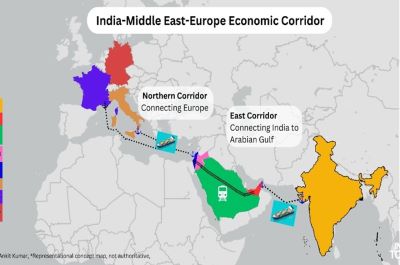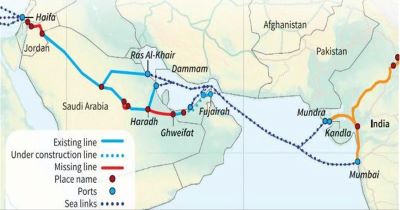Context:
Amidst the worsening Red Sea supply chain crisis, India must explore alternatives to safeguard its economic interests. The India-Middle East-Europe Economic Corridor (IMEC) emerges as a strategic alternative to the disrupted Red Sea route.
The India-Middle East-Europe Economic Corridor (IMEC)
Genesis and Objectives
The IMEC, introduced during the New Delhi G20 Leaders’ Summit in September 2023, is an ambitious project born from the Abraham Accords and the normalization of relations between Middle Eastern nations. It aims to enhance connectivity through various infrastructures including renewable energy grids, free trade zones, hydrogen pipelines, undersea cables, and integrated digital finance infrastructure. Despite its potential, the IMEC faces several challenges.
The IMEC's conception is deeply rooted in the Abraham Accords and the I2U2 grouping, which includes India, the US, Israel, and the UAE. The initial virtual summit of I2U2 in July 2022 highlighted strategic transport links as a focus area. Saudi Arabia's involvement, driven by ongoing diplomatic efforts between Riyadh and Tel Aviv, and Israel's enthusiastic support, has shaped the corridor's foundation. The corridor was envisioned to foster regional peace and prosperity, building on recent diplomatic trends in West Asia.
● Structure and Routes
The IMEC features two main legs:
○ Eastern Leg: Container traffic would travel from India to the UAE by sea and then move by rail through Saudi Arabia and Jordan to Haifa port in Israel.
○ Western Leg: From Haifa, containers would be shipped to European ports and then transported by rail to their final destinations in Europe.
● Comparison with China’s Belt and Road Initiative (BRI)
Unlike the BRI, the IMEC is not solely focused on trade. It also incorporates secure data pipelines and renewable energy grids. The corridor proposes a high-speed data pipeline and integrates the ‘One Sun, One World, One Grid’ initiative to connect regional electricity grids, promoting global renewable energy use.
● Green Hydrogen Integration
The IMEC plans to include clean hydrogen pipelines, a forward-looking move as green hydrogen is seen as a potential long-term alternative to fossil fuels. India, along with other corridor members, is investing significantly in green hydrogen projects.

Challenges Facing the IMEC
● The Red Sea Supply Chain
The Red Sea supply chain crisis, triggered by ongoing conflicts such as the Israel-Hamas war and regional instability, is causing significant disruptions. The crisis has led to congested port traffic, soaring insurance premiums, shipment delays, and increased ocean freight rates. Given that 50 percent of India’s gross national exports and 80 percent of its exports to Europe traverse the Red Sea route, these disruptions are of considerable concern. The cost of shipping through alternative routes, such as the Cape of Good Hope, has dramatically increased, exacerbating the need for a reliable alternative.
● Geopolitical and Infrastructure Issues
Saudi Arabia’s reluctance to advance IMEC cooperation until the Gaza and West Bank issues are resolved poses a significant obstacle. Additionally, the Haifa port in Israel, which is a critical component of the corridor, currently suffers from under-capacity. Furthermore, regional threats, such as Iran’s repeated threats to close the Strait of Hormuz, add another layer of risk to the corridor's viability.
● Financial Integration and Free Trade Concerns
The IMEC’s financial integration remains incomplete. While India’s digital public infrastructure, India Stack, is accessible to some corridor partners, there is a lack of standardised tariff regimes and interregional financial links. Effective implementation requires overcoming these barriers to ensure seamless cross-border transactions and financial flows.
Bolstering Economic Connectivity
● Responding to the Red Sea Crisis
Despite criticisms that the Israel-Hamas conflict has stalled IMEC developments, the ongoing Red Sea crisis underscores the need for accelerated cooperation. India’s progress with port development in the UAE and renewed commitments from G7 leaders to finance IMEC infrastructure are steps in the right direction. However, greater cohesion and strategic planning are essential.
● IMEC Free Trade Area and Financial Collaboration
For the IMEC to realise its full potential, partners must establish a standard tariff regime and improve transportation systems. Enhancing digital and financial connectivity, such as integrating India’s UPI system with international fintech ecosystems, could benefit sectors like agritech, health tech, and edtech.
● Geopolitical Risk Mitigation and Route Diversification
The IMEC must address geopolitical risks by diversifying routes within the corridor. Adding Oman and Egypt as partners could mitigate risks associated with the Strait of Hormuz and the Red Sea. Additionally, incorporating Italy’s Trieste port could provide a crucial gateway to Europe, linking to Europe’s manufacturing hubs and enhancing trade with the Indo-Pacific region.
● Enhanced Coordination
The IMEC’s primary challenge is ensuring continuous cooperation between participating countries. The development of rail routes, power lines, and pipelines, with an estimated cost of approximately US$20 billion, requires both governmental and private investments. Effective internal and external policy coordination is crucial to avoid inefficiencies caused by disjointed transport connectivity and customs facilities.
● Inclusion and Sustainability
The IMEC emphasizes inclusivity and climate considerations. While the corridor focuses on renewable energy and green hydrogen, it is essential to build sustainable procurement and production mechanisms into the infrastructure development framework.
● Digital Advancements
The COVID-19 pandemic underscored the importance of digital trade facilitation. The IMEC’s inclusion of digital connectivity aligns with frameworks like the United Nations agreement on cross-border paperless trade, which addresses supply chain disruptions and promotes resilient and inclusive trade.
The IMEC and India
● Economic Growth and Demand: India’s large population and rising real incomes create a strong demand base. The country’s demographic dividend, access to finance, and infrastructure development bolster its economic potential. Additionally, the need for a green transition presents new opportunities.
● Trade Policy Evolution: India’s trade facilitation efforts, including recent agreements with the UAE and the European Free Trade Association, highlight its shifting stance from protectionism. The IMEC offers a template for integrating India into global value chains (GVCs), counteracting its previous inward-looking policies.
● GVC Participation: With a current GVC participation rate below the global average, India has an opportunity to enhance its role in the evolving GVC landscape. The IMEC can help India attract lead firms and integrate with global value chains, especially as the global pandemic and geopolitical shifts necessitate diversification.
● Strategic Trade Partnerships: The IMEC aligns India’s economic strengths with its strategic location, offering potential for enhanced trade with the GCC nations. India’s trade with the GCC already exceeds US$184 billion, and an expanded free trade agreement could boost this figure significantly.
Conclusion
The IMEC exemplifies the synergy between transport connectivity and trade facilitation. It holds the potential to transform trade dynamics between Asia and Europe and offers significant opportunities for India to diversify supply chains and enhance economic resilience. Despite existing challenges, its potential benefits are substantial. Achieving the corridor’s full potential requires deeper economic integration, improved financial and digital connectivity, robust risk mitigation strategies, and an expanded network of partners. The success of the IMEC will depend on the commitment and cooperation of all participating nations.
|
Probable Questions for UPSC Mains 1. Discuss the strategic significance of the India-Middle East-Europe Economic Corridor (IMEC) in enhancing global trade connectivity and countering disruptions in the Red Sea supply chain. How does the IMEC compare to China’s Belt and Road Initiative (BRI) in terms of its objectives and key features? (10 Marks, 150 Words) 2. Evaluate the challenges faced by the India-Middle East-Europe Economic Corridor (IMEC) in its implementation, including geopolitical, infrastructural, and financial obstacles. How can India leverage its economic strengths and strategic location to maximise the benefits of the IMEC? (15 Marks, 250 Marks) |
Source: ORF India









